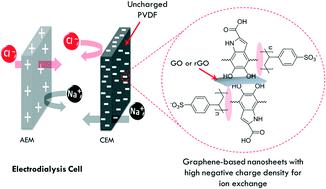当前位置:
X-MOL 学术
›
Environ. Sci.: Nano
›
论文详情
Our official English website, www.x-mol.net, welcomes your feedback! (Note: you will need to create a separate account there.)
Graphene-PSS/L-DOPA nanocomposite cation exchange membranes for electrodialysis desalination
Environmental Science: Nano ( IF 7.3 ) Pub Date : 2020-08-19 , DOI: 10.1039/d0en00496k Adetunji Alabi 1, 2, 3, 4 , Levente Cseri 5, 6, 7, 8 , Ahmed Al Hajaj 2, 3, 4, 9 , Gyorgy Szekely 5, 6, 7, 8, 10 , Peter Budd 6, 7, 8, 11 , Linda Zou 1, 2, 3, 4
Environmental Science: Nano ( IF 7.3 ) Pub Date : 2020-08-19 , DOI: 10.1039/d0en00496k Adetunji Alabi 1, 2, 3, 4 , Levente Cseri 5, 6, 7, 8 , Ahmed Al Hajaj 2, 3, 4, 9 , Gyorgy Szekely 5, 6, 7, 8, 10 , Peter Budd 6, 7, 8, 11 , Linda Zou 1, 2, 3, 4
Affiliation

|
This research reports the fabrication of nanocomposite cation exchange membranes (CEMs) by incorporating negatively charged graphene-based nanomaterials into a non-charged poly(vinylidene fluoride) (PVDF) matrix using a mold-casting technique developed in-house. Graphene oxide (GO) or reduced graphene oxide (rGO) nanosheets were modified into ion exchange group carriers using a sulfonic acid group-bearing agent based on poly(sodium 4-styrenesulfonate)/3,4-dihydroxy-L-phenylalanine (PSS/L-DOPA) (SGO or SrGO). Such modified nanosheets provide the ion exchange capabilities in SGO/PVDF and SrGO/PVDF nanocomposite CEMs, respectively. Both nanocomposite CEMs displayed lower linear swelling ratios which are good for membrane stability. This was due to the presence of nanomaterials which acted as pore fillers and increased the stiffness of the nanocomposite membranes. The ion exchange capacity (IEC) and permselectivity of the SGO/PVDF_45 CEM were slightly higher than the values for the SrGO/PVDF_45 CEM. It was found that the SrGO additive increased the area resistance of the nanocomposite CEM. However, SrGO/PVDF_45 CEM demonstrated a higher current efficiency (7.5% higher than that of SGO/PVDF_45), which could be attributed to the improved electronic conductivity of rGO. It was found that both nanocomposite CEMs performed well in electrodialysis experiments to achieve substantial salt removal rates, although the energy consumption results of the novel nanocomposite CEMs were higher than the conventional polymeric CEM. The above research results have successfully demonstrated the concept of fabricating nanocomposite cation exchange membranes (CEMs) for electrodialysis applications by employing negatively charged graphene-based nanomaterials as ion exchange carriers.
中文翻译:

用于电渗析脱盐的石墨烯-PSS / L-DOPA纳米复合阳离子交换膜
这项研究报告了通过使用内部开发的铸模技术将带负电的石墨烯基纳米材料掺入不带电的聚偏二氟乙烯(PVDF)基质中来制造纳米复合阳离子交换膜(CEM)。使用基于聚(4-苯乙烯磺酸钠)/ 3,4-二羟基-L-苯丙氨酸(PSS /的磺酸基)的载剂将氧化石墨烯(GO)或还原氧化石墨烯(rGO)纳米片改性为离子交换基团载体大号-DOPA)(SGO或SrGO)。这种改性的纳米片材分别在SGO / PVDF和SrGO / PVDF纳米复合材料CEM中提供离子交换功能。两种纳米复合材料CEM均显示出较低的线性溶胀率,这有利于膜的稳定性。这是由于存在充当孔填充剂并增加了纳米复合膜的刚度的纳米材料。SGO / PVDF_45 CEM的离子交换容量(IEC)和渗透选择性略高于SrGO / PVDF_45 CEM的值。已经发现,SrGO添加剂增加了纳米复合材料CEM的面积电阻。但是,SrGO / PVDF_45 CEM表现出更高的电流效率(比SGO / PVDF_45高7.5%),这可以归因于rGO的电子电导率提高。发现两种纳米复合材料CEM在电渗析实验中均表现良好,可实现相当高的除盐率,尽管新型纳米复合材料CEM的能耗结果高于常规聚合物CEM。以上研究结果已经成功地证明了通过使用带负电的石墨烯基纳米材料作为离子交换载体来制造用于电渗析应用的纳米复合阳离子交换膜(CEM)的概念。
更新日期:2020-10-17
中文翻译:

用于电渗析脱盐的石墨烯-PSS / L-DOPA纳米复合阳离子交换膜
这项研究报告了通过使用内部开发的铸模技术将带负电的石墨烯基纳米材料掺入不带电的聚偏二氟乙烯(PVDF)基质中来制造纳米复合阳离子交换膜(CEM)。使用基于聚(4-苯乙烯磺酸钠)/ 3,4-二羟基-L-苯丙氨酸(PSS /的磺酸基)的载剂将氧化石墨烯(GO)或还原氧化石墨烯(rGO)纳米片改性为离子交换基团载体大号-DOPA)(SGO或SrGO)。这种改性的纳米片材分别在SGO / PVDF和SrGO / PVDF纳米复合材料CEM中提供离子交换功能。两种纳米复合材料CEM均显示出较低的线性溶胀率,这有利于膜的稳定性。这是由于存在充当孔填充剂并增加了纳米复合膜的刚度的纳米材料。SGO / PVDF_45 CEM的离子交换容量(IEC)和渗透选择性略高于SrGO / PVDF_45 CEM的值。已经发现,SrGO添加剂增加了纳米复合材料CEM的面积电阻。但是,SrGO / PVDF_45 CEM表现出更高的电流效率(比SGO / PVDF_45高7.5%),这可以归因于rGO的电子电导率提高。发现两种纳米复合材料CEM在电渗析实验中均表现良好,可实现相当高的除盐率,尽管新型纳米复合材料CEM的能耗结果高于常规聚合物CEM。以上研究结果已经成功地证明了通过使用带负电的石墨烯基纳米材料作为离子交换载体来制造用于电渗析应用的纳米复合阳离子交换膜(CEM)的概念。



























 京公网安备 11010802027423号
京公网安备 11010802027423号